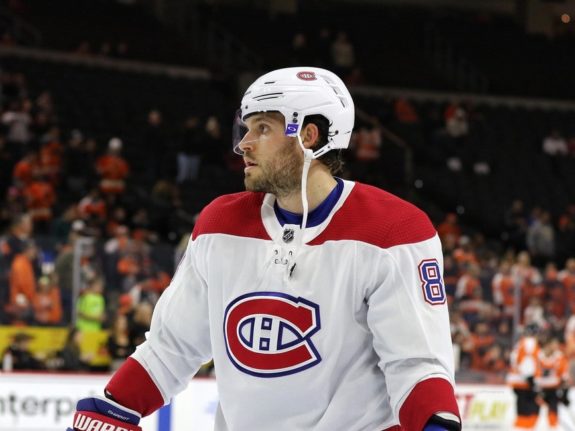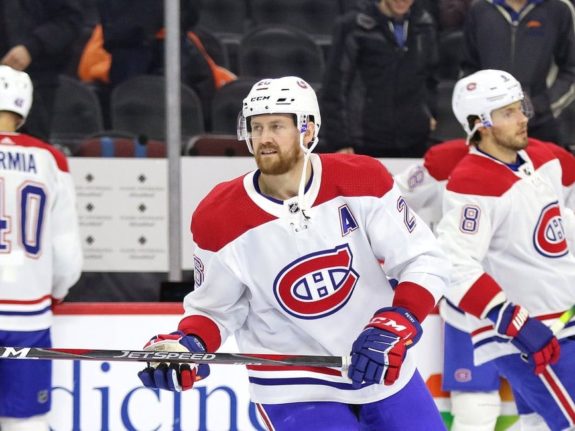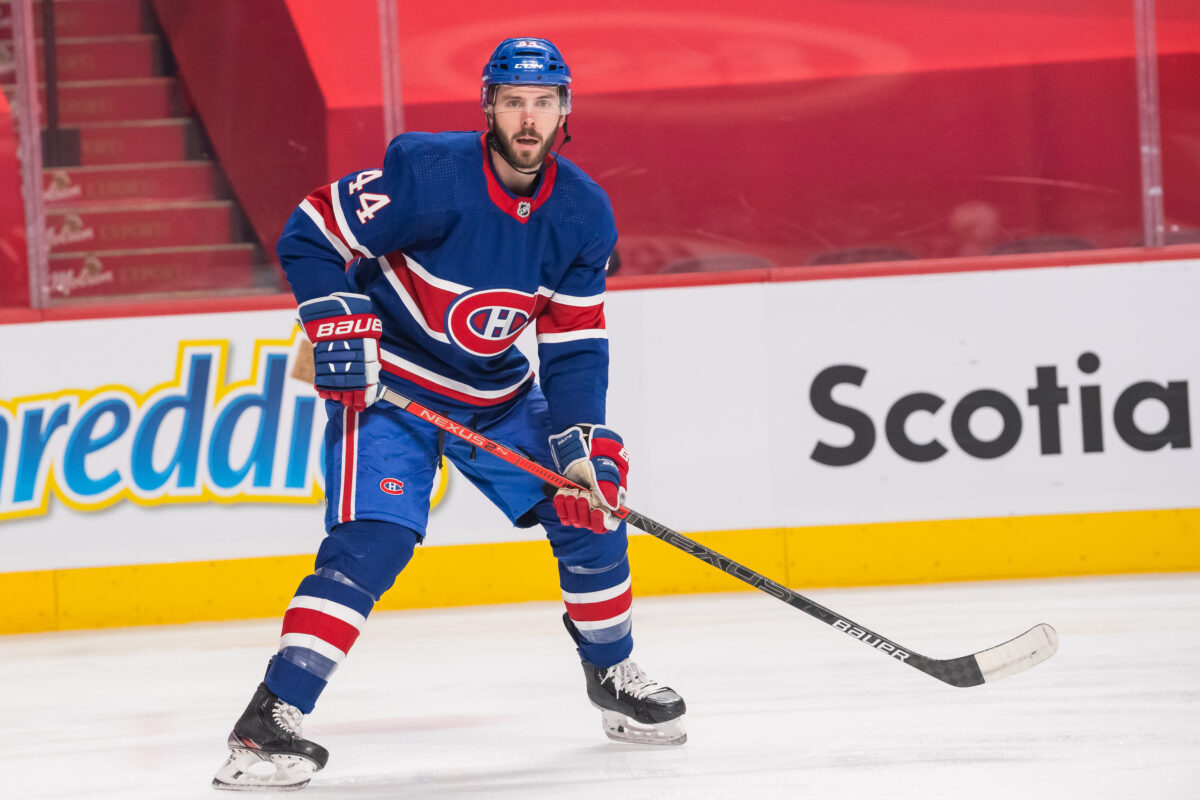It’s too soon to suggest that the Montreal Canadiens’ postseason run is a true Cinderella story, but the most storied franchise in NHL history has overcome the odds to reach the Stanley Cup Final for the first time in 28 years. Their success has mostly come on the backs of their top-two defensive pairings, which have stifled the opposition’s ability to generate offensive chances.
It may have been a bit of an exaggeration when interim head coach Luke Richardson referred to his top-four defensemen as “having four Prongers out there” during the conference finals against the Vegas Golden Knights, but their defensive strategy – of collapsing the slot, blocking shots, and checking bodies off the puck – has been effective. Though I don’t intend to cover all aspects of their game, I want to look at the ups and downs of the Canadiens’ top-two defensive pairings and why they have had so much success.
Shea Weber
There’s a reason why Shea Weber is the club’s captain. He’s not only a veteran leader on a fairly young team, but he can tilt a game in the Canadiens’ favour with his defensive play. At 35 years old, he still makes his presence felt, as we’ve seen throughout the postseason, whether it’s battling along the boards or in front of the net. While he’s not one to wear his emotions on his sleeve, we’ve seen glimpses that he wants nothing more than to raise the Stanley Cup over his head for the first time in his 16-year NHL career.
Weber has been averaging roughly three more minutes of ice time (TOI) per game in the postseason compared to the regular season because the coaching staff reduced the TOI of the third pairing. The added time hasn’t fazed Weber in the slightest, averaging 25:37 per game, with 60 hits and 31 blocked shots.

He’s not only engaged in just about every play, but he’s gravitating toward the puck. He’s not lingering in front of the net, waiting for something to happen, he’s making sure he’s in the right place at the right time.
Weber also has five takeaways this postseason, which is helpful on a team that is so effective off the rush. While the Canadiens have struggled to sustain offensive zone time, they are dangerous when they have room to move the puck up ice. One takeaway and a flip pass up the middle could mean a breakaway, which has happened time and again this postseason.
He scored his only goal of the postseason (he also has four assists) in Game 6 against Vegas to open the scoring and secure Montreal’s Stanley Cup Final berth.
Ben Chiarot
Ben Chiarot has been effective as Weber’s defensive partner. Weber can gravitate toward the puck when it’s along the boards because he trusts his partner to clean up any possible scoring chance as a result. It’s hard to find that kind of chemistry, but the problem is that Chiarot takes risks with and without the puck. He may be a shut-down defender, but he’s more likely than the others to be caught out of position.
Like Weber, Chiarot is big and physical, at 6-foot-3 and 225 pounds, and he’s difficult to play against. He will make you pay for hanging around the net, and he leads the Canadiens’ top-four defenders in hits (64) this postseason. While Weber is more likely to pin an opposing player against the boards, as his teammate picks the puck loose, Chiarot will remove his opponent from the play with a big hit.

He has 41 blocked shots and six takeaways this postseason, but he’s also given up the puck 34 times. He’s an aggressive player who likes to get involved in the play despite the risks. In Game 1 of the Stanley Cup Final against the Tampa Bay Lightning, Chiarot deflected the puck into his own net, a back-breaker in what became a 5-1 loss. It may have been an unlucky bounce, but better positional awareness might have prevented the goal.
Montreal has been accused of playing boring hockey, but that’s a good thing for defensemen because the opposition’s offense isn’t showing up on the highlight reels. Chiarot needs to focus on making the offensive chances against as boring as possible. Sometimes his risks favour his team, and sometimes they end badly. His objective in Game 2 against the Lightning should be to stick with the team’s system: play steady, lockdown defense, avoid risky plays and hits that take him out of the play.
Jeff Petry
There’s a reason Jeff Petry has been with the Canadiens longer than any other defenseman on the roster. While he sometimes makes questionable plays, he is the defender most likely to join the rush and create scoring chances. He’s not afraid to carry the puck into the offensive zone and wait for the offence to get set up. None of the other top-four does this as often.
Petry’s absence was felt during Game 1 against Vegas when the team struggled with zone entries, and stretch passes became an issue. He’s averaging almost 25 minutes TOI this postseason, and he’s been arguably the most impactful defender on the team. He has the fewest penalty minutes of the top four (two minutes), which means he’s competing and being effective physically without hurting his team.

Petry is also arguably the Canadiens’ best defenseman at puckhandling. Although he has yet to score this postseason (after contributing 12 goals during the regular season), he’s registered five assists and put up 20 shots. The only defender with more points on the team is his partner, Joel Edmundson (six points).
Petry is a playmaker and even when he isn’t hitting the scoresheet, he’s giving his teammates a chance to make quality plays. The Canadiens’ success in the Final will depend partly on Petry’s ability to stay healthy and produce at a high level.
Joel Edmundson
Point production is not what comes to mind when I think of Joel Edmundson, who has no problem wreaking havoc on the opposition. Like Chiarot, Edmundson plays a physical game, with 50 hits and 23 blocked shots this postseason.
Edmundson, like Petry, has maintained his physical game in the postseason without taking penalties. He has three penalties in 18 games, which is impressive for a defensive system that’s built to shut down the slot. The Petry/Edmundson pairing has been effective and clean at keeping the slot clear.

Edmundson (six assists) and Petry (five assists) have combined for 11 assists in 18 games. While he’s not the most mobile defender on the team, nor the best puck-handler, he has vision and can cut off defenders coming down the boards. His stretch passes into the neutral zone have created many scoring chances, and though he won’t appear on the highlight reel very often, he does what he needs to do when he needs to do it.
In their Game 1 loss, Edmundson showed his frustration against the Lightning, but if he can stay disciplined, he will play a major role in the Canadiens’ success en route to their 25th Stanley Cup.
Stick to the System
The Canadiens’ defence may not be the best in the league, but when they play as a unit, they are near-impossible to score on. Since they were down 3-1 in their first-round series against the Toronto Maple Leafs, Montreal’s top-four defensemen have been an absolute force. To lose even one of them for a game would hurt the team, as we saw against Vegas.
Tampa Bay is a strong offensive team, and the Canadiens’ top-four will need to make their presence felt going forward and improve on the mistakes made in Game 1. For a team that plays a trap game, Montreal’s defence plays best when they are close, clogging up the slot and the neutral zone. The Stanley Cup is within their reach, but the top-four will need to continue shutting down the slot, forcing the opposition to the outside, and making good neutral-zone passes. Success will come if they stick to the game plan.